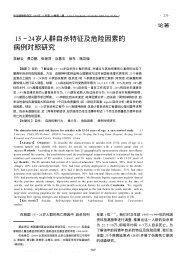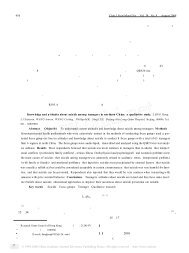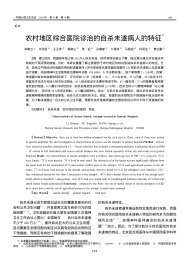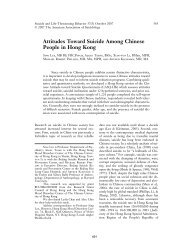Interventions for Suicide Survivors: A Review of the Literature
Interventions for Suicide Survivors: A Review of the Literature
Interventions for Suicide Survivors: A Review of the Literature
You also want an ePaper? Increase the reach of your titles
YUMPU automatically turns print PDFs into web optimized ePapers that Google loves.
Jordan and McMenamy 343<br />
cult to draw conclusions about <strong>the</strong> superior- each 2-hour session into a problem-focused<br />
ity <strong>of</strong> group interventions over non-interven- psychoeducational and skill building compotion.<br />
nent, followed by an emotion-focused sup-<br />
Building on <strong>the</strong> writing intervention portive discussion. The problem-focused comdeveloped<br />
by Pennebaker (see Pennebaker, ponent was designed to provide in<strong>for</strong>mation<br />
Zech, & Rime, 2001 <strong>for</strong> a recent summary), and skills to reduce negative consequences <strong>of</strong><br />
Kovac and Range (2000) reported on a prom- bereavement after violent death. The emotion-<br />
ising intervention that asked undergraduate focused component was structured to <strong>of</strong>fer<br />
student suicide survivors to write about <strong>the</strong> emotional sharing and support among mem-<br />
suicide <strong>of</strong> a loved one. Forty subjects were bers, as well as cognitive reframing <strong>of</strong> aspects<br />
randomly assigned to write ei<strong>the</strong>r about <strong>the</strong>ir <strong>of</strong> <strong>the</strong> loss experience. Outcome measures assuicide<br />
loss or about a neutral subject four sessed parents’ levels <strong>of</strong> mental distress, post-<br />
times over a 2-week period. Participants were traumatic reactions, loss accommodation (grief<br />
given self-report measures <strong>of</strong> suicide specific response), physical health, and marital role<br />
and general grief reactions, trauma symp- strain. Assessments were made prior to be-<br />
toms, and indicators <strong>of</strong> health care utilization ginning <strong>the</strong> intervention, at <strong>the</strong> conclusion,<br />
on three occasions: immediately be<strong>for</strong>e and and 6 months post intervention.<br />
after <strong>the</strong> intervention, and 6 weeks post in- Based on previous indications that men<br />
tervention. Results indicated significant de- and women may respond differentially to be-<br />
creases in suicide specific grief, although not reavement support interventions, data was<br />
in general grief, trauma symptoms, or health analyzed separately <strong>for</strong> fa<strong>the</strong>rs and mo<strong>the</strong>rs.<br />
care utilization among <strong>the</strong> treatment group. In general, <strong>the</strong> intervention did not prove to<br />
The authors concluded that writing interven- be superior to <strong>the</strong> control situation in reduc-<br />
tions might be particularly suited <strong>for</strong> being symptoms associated with <strong>the</strong> loss. Of<br />
reavement after suicide, noting that many importance, however, was a significant inter-<br />
participants in <strong>the</strong> intervention group made action between gender and initial distress<br />
spontaneous comments that participation had level in <strong>the</strong> treatment group. When partici-<br />
allowed <strong>the</strong>m to better understand why <strong>the</strong> pants were grouped by initial level <strong>of</strong> distress,<br />
death had occurred and to begin talking to bereaved mo<strong>the</strong>rs with initially high levels <strong>of</strong><br />
o<strong>the</strong>rs about <strong>the</strong> death. The authors also sug- emotional distress and grief symptoms had<br />
gested that, based on a previous meta-analy- lower levels <strong>of</strong> <strong>the</strong>se symptoms at <strong>the</strong> conclu-<br />
sis <strong>of</strong> similar interventions, this approach sion <strong>of</strong> <strong>the</strong> intervention in comparison to<br />
may be particularly helpful <strong>for</strong> males, who control group mo<strong>the</strong>rs. Fur<strong>the</strong>rmore, particiare<br />
less likely to disclose traumatic experipation in <strong>the</strong> intervention appeared to inences<br />
to o<strong>the</strong>rs (Smyth, 1998). crease <strong>the</strong> PTSD symptoms <strong>of</strong> fa<strong>the</strong>rs in <strong>the</strong><br />
In one <strong>of</strong> <strong>the</strong> most methodologically treatment group. As with most o<strong>the</strong>r prorigorous<br />
studies to date, Murphy and her col- gram descriptions, participants generally in-<br />
leagues reported on <strong>the</strong> efficacy <strong>of</strong> a 10-week dicated great satisfaction with <strong>the</strong> program.<br />
support group intervention <strong>for</strong> 261 bereaved In addition to <strong>the</strong> clinical trial <strong>of</strong> this<br />
parents (Murphy, 2000; Murphy et al., 1998). intervention, Murphy (2000) has reported<br />
Parents who had experienced <strong>the</strong> sudden data from a longitudinal follow-up at 2 and 5<br />
death <strong>of</strong> a child (aged 12 to 28) by suicide, years that combined <strong>the</strong> treatment and con-<br />
homicide, or accidental death within <strong>the</strong> 7 trol groups. The sample continued to show<br />
months prior to recruitment were identified greatly elevated levels <strong>of</strong> mental distress,<br />
through death records and invited into <strong>the</strong> trauma symptoms, and health problems at 2<br />
study. All parents were randomly assigned to and 5 years, although <strong>the</strong>re was a steady de-<br />
ei<strong>the</strong>r a treatment or a nontreatment control cline in symptoms over <strong>the</strong> course <strong>of</strong> <strong>the</strong><br />
condition. The intervention consisted <strong>of</strong> a study. Murphy also noted that parents who<br />
<strong>the</strong>ory-based group program which divided engaged in certain health protective behav-

















